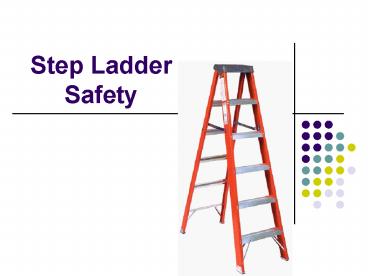Step Ladder Safety - PowerPoint PPT Presentation
1 / 16
Title:
Step Ladder Safety
Description:
Falls from ladders injure more than 20,000 workers per year1. UF: ... 2. Liberty Mutual's 2005 Workplace Safety Index. 3. Survey of Corporate Decision Makers ... – PowerPoint PPT presentation
Number of Views:718
Avg rating:3.0/5.0
Title: Step Ladder Safety
1
Step Ladder Safety
2
Step Ladder Safety
- A common piece of equipment used on most every
construction site - Widely used in around homes
3
Ladder Types
- Type IA
- 300 Pound
- Construction areas
- Type I
- 250 Pound
- Industry light construction
- Type II
- 225 Pound
- Commercial ladder for light maintenance office
use - Type III
- 200 Pound
- Household use
4
Injury Statistics
- Falls from ladders injure more than 20,000
workers per year1 - UF 50,912 students as of Fall 2006
- 80 of all falls occur at the top of the ladder 1
- 50 of falls occur during the transition from the
ladder to a second surface1 - Direct compensation and medical treatments
associated with falls from elevation cost
American businesses 4.6 billion2 - Indirect costs can cost up to twice as much3
1. U.S. Bureau of Labor Statistics 2. Liberty
Mutuals 2005 Workplace Safety Index 3. Survey of
Corporate Decision Makers
5
OSHA Subpart X Stairways and Ladders
1926.1051 1926.1053
- 1926.1051 (b) Employers shall provide and
install all stairway and ladder fall protection
systems required by this subpart - 1926.1053 (a) 1 (I) Each self-supporting
portable ladder at least 4 times maximum
intended load, except heavy-duty 1A metal or
plastic ladder 3.3 time maximum load - (a) 2 Ladder rungs, cleats, and steps shall be
parallel, level, and uniformly spaced when the
ladder is in position for use - (a) 3 (I) Rungs, cleats, and steps of portable
ladders shall be spaced not less than 10 inches
apart, nor more than 14 inches apart, as measured
between center lines of the rungs, cleats and
steps
GOOD
BAD
6
OSHA Subpart X Stairways and Ladders
1926.1053
GOOD
- (a) 5 The rungs of step ladders shall be shaped
such that employees feet cannot slide off the
end of the rungs - (b) 8 A metal spreader or locking device shall
be provided on each stepladder to hold the front
and back sections in an open position when the
ladder is in use
BAD
7
OSHA Subpart X Stairways and Ladders
1926.1053
- (b) 1 When portable ladders are used for access
to an upper landing surface, the ladder side
rails shall extend at least 3 feet above the
upper landing surface to which the ladder is used
to gain access - 2 Ladders shall be maintained free of oil,
grease, and other slipping hazards. - (b) 3 Ladders shall not be loaded beyond the
maximum intended load for which they are built,
nor beyond their manufacturers rated capacity - (b) 4 Ladders shall be used only for the purpose
for which they were designed.
GOOD
BAD
8
OSHA Subpart X Stairways and Ladders
1926.1053
GOOD
- (b) 6 Ladders shall be used only on stable and
level surfaces unless secured to prevent
accidental displacement - (b) 7 Ladders shall not be used on slippery
surfaces unless secured or provided with
slip-resistant feet - (b) 8 Ladders placed in any location where they
can be displaced by workplace activities or
traffic, such as in passageways, doorways, or
driveways, shall be secured to prevent accidental
displacement or a barricade shall be used to keep
the activities or traffic away from the ladder
BAD
9
OSHA Subpart X Stairways and Ladders
1926.1053
GOOD
- (b) 9 The areas around the top and bottom of
ladders shall be kept clear. - (b) 11 Ladders should not be moved, shifted, or
extended while occupied. - (b) 13 The top or top step of a ladder shall not
be used as a step. - (b) 14 Cross-bracing on the rear section of
stepladders shall not be used for climbing unless
the ladders are designed and provided with steps
for climbing on both front and rear sections.
VERY BAD
10
OSHA Subpart X Stairways and Ladders
1926.1053
GOOD
- (b) 15 The ladder shall be inspected by a
competent person for visible defects on a
periodic basis and after any occurrence that
could affect their safe use. - (b) 16 Portable ladders with structural defects
shall either be immediately marked in a matter
that readily identifies them as defective, or be
tagged with Do Not Use or similar language, and
shall be withdrawn from service until repaired. - (b) 18 Ladder repairs shall restore the ladder
to a condition meeting its original design
criteria, before the ladder is returned to use.
Do Not Use
BAD
11
OSHA Subpart X Stairways and Ladders
1926.1053
- (b) 20 When ascending or descending a ladder,
the user shall face the ladder. - (b) 21 Each employee shall use a least one hand
to grasp the ladder when progressing up or down
the ladder. - (b) 22 An employee shall not carry any object or
load that could cause the employee to lose
balance and fall.
GOOD
BAD
12
OSHA Subpart X Stairways and Ladders
1926.1060
- (a) The employer shall provide a training program
for each employee using ladders and stairways, as
necessary. The program shall enable each employee
to recognize hazards related to ladders and
stairways, and shall train each employee in the
procedures to be followed to minimize these
hazards. - (b) Retraining shall be provided for each
employee as necessary so that the employee
maintains the understanding and knowledge
acquired through compliance with this subject.
13
Safety Tips
- Follow Safety Instructions located on ladder
sticker
14
Safety Tips
15
Three Point Rule
16
Be Careful!The End
Bad Way to Climb Corporate Ladder






























